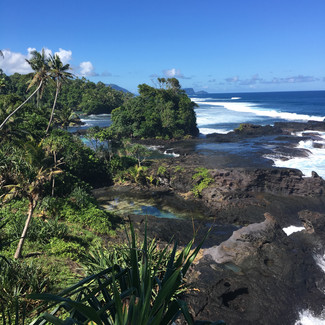It’s island time. No rush, take a seat.
- Katarina Slemenik
- Jun 12, 2018
- 3 min read
Before flying to Samoa I didn’t expect much. I didn’t read much about the island, neither I planed what to see and where to stay. I just knew I’m going to the Pacific where is hot and humid and the life pace slows down.

What I’ve learned about Samoa after two weeks traveling around?
Samoa is an independent country since 1962. Before that it was colonized by New Zealand and Germany. It was the first independent country in the South Pacific. The two main islands are Savai’i and Upolu with the population of 190.000 people. They mostly grow papayas, bananas, pineapples, coconuts, taro (like potato) and mainly export dry coconut meat and cocoa beans for chocolate.
Sunday is time for church, family, a lot of food and rest. Samoan people are mostly Christians so going to church is a must-do thing every Sunday.
Except in the capital, there are no supermarkets, just small shops where you can buy really basic things like water (not always), sweet drinks (plenty of them), chips, cookies, sugar and maybe rice. If you’re lucky you’ll find a lady by the road selling 3 papayas, 10 coconuts and 5 cucumbers. So you really must be lucky to get some fruits or veggies.
The cheapest way of accommodation is an open fale - a wooden cottage with no door and windows. It is really simple and always with the best beach view possible. They are practically on the beach so after waking up you only need to do a few steps and you’re in the water. When sleeping in fales, breakfast and dinner are always included. If you like meat, you’ll be surprised about the quality of it. They usually serve chicken and pork with rice, taro (their type of potato) and some veggies. The pigs and chickens are walking around freely and eat coconuts. So you need to be careful not to hit them with the car as they move at the same slow pace as locals. Eventhough there is not much vegetables, the food you get is always fresh and delicious.
One of the most interesting facts here is that people accept boys who dresses up as women. Traditionally, if a family had more boys than girls or not enough girls to help with women's duties about the house, male children would be chosen to be raised as fa'afafine - Samoans, identified as a third gender. On the other hand, they strictly don’t except lesbians and gays. It is not allowed to be in love with the same gender. Fa'afafine are part of their culture and tradition whereas homosexuality is not something they recognize as “normal”.
Prices:
One beer (0,75) in a shop 6,5 WST (2,15€)
One beer (0,33) in a resort 10 WST (3,3€)
2l of water in a supermarket 2,2 WST (0,7€)
Coconut on the market 1 WST (0,3€)
One papaya from the lady selling on the road 3 WST (quite sure locals pay less) (1€)
Accommodation in beach fale with breakfast and dinner 70 WST (23€)
1l of petrol 2,7 WST (0,9€)
One day car rental 120 WST (40€)
Samoa is definitely worth a visit, especially if you are traveling around New Zealand and want to escape to the Pacific paradise for a week or two. The people are super friendly and always smiling. It is amazing how happy they are with such a simple life, not having much. They are always eager to talk with tourists and ask them questions. If you come here, make sure you switch to the “island time” and you’ll have a lot of fun.
After two weeks of discovering Samoa it is time to be a bit more productive and experience the work in a 4* resort. More about that and how our work got canceled two days before the start in my next blog post.





































Comments